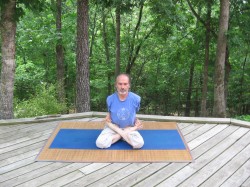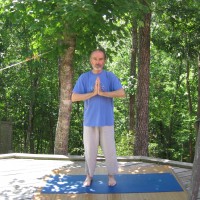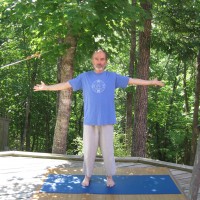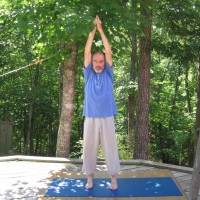
The four great yogas are: 1) Raja Yoga; 2) Bhakti Yoga; 3) Gyan Yoga; and 4) Karma Yoga.
Raja Yoga is also known as Ashtanga Yoga and consists of the following parts:
1) Yamas: things not to do:
A) Ahimsa—harmlessness (vegetarian), non-killing;
B) Satya—truthfulness, non-lying;
C) Asteya—non-theft;
D) Brahmacharya—non-indulgence;
E) Aparigraha—simplicity, non-covetousness.
2) Niyamas: things to do:
A) Shaucha—cleanliness;
B) Santosha—contentment;
C) Tapas—austerity;
D) Svadhyaya—study of spiritual literature;
E) Ishavarapranidhana—faith and surrender.
3) Asana:
This means posture comfortably held. It is worth noting that doing the postures follows the yamas and niyams, which many of us are still struggling to develop. Much of the yoga in the media is focused on this one aspect of doing asanas.

4) Pranayama includes:
Puraka (inhalation)
Rechaka (exhalation)
Kumbhaka (holding the breath), which is further divided into:
Antara kumbhak (withholding the breath after inhalation)
Bahar kumbhak (withholding the breath after exhalation)
(It is advised/suggested that one not practice pranayama without personal guidance from an adept. One could practice simple deep breathing exercises without too much difficulty).
Deep Breathing: One to two sets, 10 times



A. Stand with the feet parallel, shoulder width. Bring your palms together in a prayer position and touch your thumbs to the third eye center with the index fingers resting on the forehead.
B. Bring the hands down and bump the center of the chest with the fat part of the thumbs. Simultaneously start sucking the air in through the nose using the throat muscles and breathing into the area below the navel, which makes a ssaaa sound as the air rushes over the palate.
C. Use the diaphragm to fill the lungs from bottom to the top.
D. As the lungs are filling, the hands are dropping down, out and then over the top of the head interlacing the thumbs, palms flat together as the lungs are filled.
E. With the hands over the head stretch up as far as possible on the balls of the feet while holding the breath.
F. Drop down on the heels. Start exhaling with the mouth open, making a “hhaaa” sound as you stretch the hands out, down and away from the head. The arm movement finishes by pressing in on the sides of the chest with the inner and upper part of the arms as the hands come to rest at the eye center, thumbs together. During the exhaling breath, first relax the chest, then the stomach, and at last the diaphragm pushes up, completely squeezing the lungs empty. The hands are palms together, at the eye center, with the upper arms pushing in on the chest, elbows touching, to complete the first complete yogic breath. Practice 10 breaths.
The complete yogic breath is more than ‘belly’ breathing because after expanding the abdomen, then the chest is expanded to make the breath complete. When exhaling, it is very important to use the upper arms and diaphragm to completely empty the lungs without strain.
Air carries ‘prana’, the life energy. Breathing involves three processes:
1) Filling the lungs
2) Exhalation
3) Retention of the breath either with the lungs full or empty.
In yoga philosophy, a person’s life is measured in terms of the number of breaths. Therefore, deep slow breathing promotes a longer and calmer life. Problems of improper breathing include hiccough, gas, asthma, cough, mucus, pains in head or joints and nervousness. These can also be termed as vatta (air + ether) imbalances.
The prana that pervades the body is classified into the following categories in Ayurvedic medical theory according to the various functions it performs:
1) Prana pervades the heart and controls respiration.
2) Apana is located in the lower abdomen and controls the functions of elimination and expelling the fetus.
3) Samana stokes the gastric fires to aid digestion.
4) Udana dwells in the thoracic cavity and controls the intake of air and food.
5) Vyana pervades the entire body and distributes the energy derived from food and breath.
6) Pratyahara basically means withdrawal from sense perception and focus within.
7) Dharana is the concentration that results from withdrawing into oneself.
Preparation:
A. Sit in the comfortable, easy position with back straight. Resting the wrists on the knees or lap. The thumb can be lodged between the index and middle fingers or what ever is comfortable.
B. Focus your attention in the forehead, between the eyebrows. Watch the thought, feel the emotion without reaction, judgment or analysis. Aware, Observe, Witness and Detach. Release the feeling and open the space between two thoughts to obtain the Utmost Un-occupiedness.
8) Dhyana, seeing the light within. A Dhyani is a true philosopher because they have seen ‘the light.’ Dhyan is a word that became Chan in Chinese Philosophy and Zen in Japan.
9) Samadhi—superconsciousness.
Bhakti Yoga is the Yoga of devotion.
It is the art of worship using the tools of high philosophy, psychology, spiritual religion, association with the spiritual teacher, repetition of mantra (jap), and service, which is prompted by divine love and/or longing for that love.
One could say that Christianity is Bhakti Yoga as it proposes love, devotion and faith in God and the savior.
Gyan or Jnana Yoga is the yoga of knowledge.
It is the knowledge of the absolute.
Gyan yoga employs:
A) Vivek—Discrimination (Neti Neti, not this not that). It is the ability to discriminate between the real and eternal and the unreal and temporal.
B) Vairagya—Detachment.
C) Shad-sampat—The Six Virtues:
Sama: Control of the mind,
Dama: Control of the senses,
Uparate: Renunciation of activities that are not necessary duties,
Titikksha: Endurance,
Shraddha: Faith,
Smadhana: Concentration.
D) Mumkahutva—Intense longing for liberation.
Scientists could be said to be Gyan yogis. If they are working for the betterment of humanity, it could be good. If they are developing bombs and technology to undermine or kill perceived ‘enemies’, this may not be so good.
Yoga is for the development, the ‘yoking’, with higher consciousness.
Karma Yoga is the yoga of works. It involves three aspects:
1) Every act is a sacrament and sacrifice to uncovering the truth within oneself.
2) One is not concerned with the results of action, but only the action.
3) One takes the ego out (thinking ‘they’ are doing it) and lets the higher power act through them. This is the ‘no mind’ and ‘emptiness’ referred to in Oriental philosophy.

Love elephant and want to go steady?
Sign up for our (curated) daily and weekly newsletters!
Apprentice Editor: Karissa Kneeland / Editor: Catherine Monkman
Photos: Patrick Holiman

 Share on bsky
Share on bsky






Read 0 comments and reply